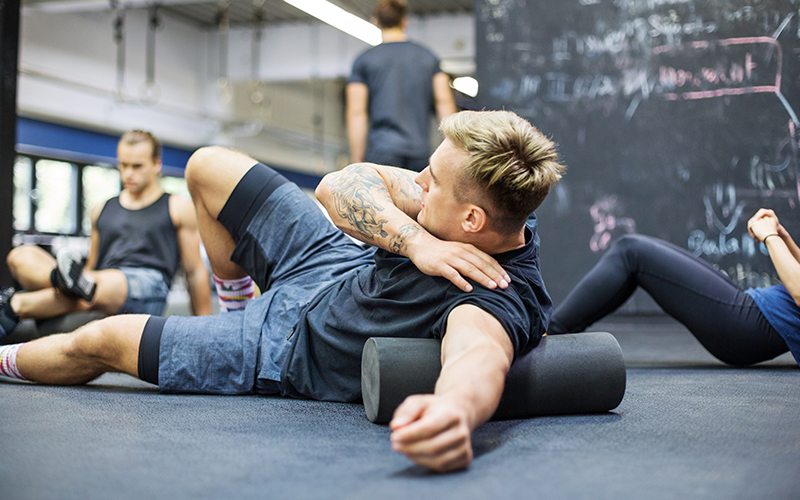Why active recovery matters: Get moving on your rest days!
 ©fizkes
©fizkes
On leg day you stumble into the locker room on wobbly legs, your arms shake after your upper body workout, and the abdominal circuit rewards your core with intense training – you always give it your all in the gym. But then you’ve got to reward yourself: with your favorite protein shake and regular recovery days. Because it’s only with sufficient recovery after a demanding workout that you can really raise your fitness level. Don’t get us wrong: A day off of training doesn’t mean lazing on the couch. Instead, many athletes rely on active recovery. We’ll let you in on their secret, show you its benefits, and get into which exercises make sense on those rest days.
The Principle of Active Recovery
Coming straight home after work and leaving your gym bag tucked away in the corner, you’re looking forward to a well-deserved rest day. Your body, and especially your sore muscles, have earned a break after a tough workout. Now you have the choice: Yes, your body will benefit from a day in which you reduce physical activities to a minimum – this is called passive recovery – when your muscles regenerate fully, and your motivation often goes through the roof afterwards.
But you can also have a rest day that doesn’t involve your maximum effort, but does include some low-intensity exercise. The goal of an active recovery workout is to accelerate the recovery process for the muscle groups you’re training.
Wondering why recovery even matters? Whether it’s deadlifts or deep squats on the multi-press, you’re targeting specific muscles during strength training. Over the course of your career in the gym, your body continually adapts to your training stimuli to keep up its performance. This means that your entire musculoskeletal system – including bones, ligaments, tendons, muscles, central nervous system, connective tissues, and metabolism – changes and improves. But this growth and adaptation can only take place if you give your body enough breaks. To brush up on the topic in general, check out our comprehensive article on strength training here.

Advantages Over Passive Recovery: Blood flow and more
Here are a few of the benefits of active recovery.
- Active recovery has one key advantage: light exercise during the active recovery phase will slightly increase blood flow to your muscles. As a result, more nutrients circulate in your blood, which has been shown to improve muscle recovery 1.
- An active recovery workout also reduces lactic acid buildup in your muscles and reduces the intensity of delayed onset muscle soreness in your abdomen, legs, and glutes2.
- Whether professional athlete or amateur, everyone loves the feeling you get after a workout. Because the hormones released during exercise have a proven positive effect on your mood3. This also applies to short and gentle active recovery sessions.
Support your muscle recovery more with your diet and nutritional supplements! Our Recovery Aminos supply your body not only with high-quality BCAAs and L-glutamine, but also with energy-rich dextrose and maltodextrin. Choose from pomegranate, wild berry, and orange flavors!

Exercises for Active Recovery Workouts
While you’re lifting heavy weights, doing sprint sessions, or alternating between burpees, jump squats, and pull-ups to test your limits on heavy workout days, you’ll need to find a different focus for your rest days. These exercises are great for active recovery days.
-
Take a walk
A leisurely stroll in the fresh air is just plain good for you. Make sure you get your heart rate up, but don’t break about 140 bpm. If you want to go to the gym, of course a comfortable stroll on the treadmill will have the same effect. Walking – like swimming, easy cycling, and water aerobics – falls into the category of steady state cardio. Slow and steady physical activity works your muscles at just the right level of intensity to reap the active recovery benefits.
-
Yoga
We’re not talking about a 90-minute vinyasa flow workout that will have you breaking a sweat, but a restorative practice like yin yoga that focuses on simple asanas and stretching. Twenty minutes promotes blood flow and relaxation. A yoga strap can be especially useful on these days. Get started with our nine yoga exercises for beginners.
-
Stretching
If yoga isn’t your thing, put together a simple stretching exercise routine! Check out our article on flexibility for some inspiration.
-
Massage
Active recovery doesn’t have to mean that you actively move your body. It also includes massages that improve circulation. Focus on areas that you worked on the day before to help fight muscle damage.
-
Fascia roller
Have a fascia roller? Great. Then take fifteen minutes and dedicate yourself to your fascia. A little time with the foam roller is ideal for massaging irritated and overworked muscles and engaging in some self myofascial release.
-
Range of Motion
Between dumbbells and barbells, sometimes your range of motion, especially in your back, can fall by the wayside. Take advantage of your active rest day and do some gentle back exercises that use your spine’s full range of motion. Dynamic flexibility and balance exercises prepare your body for the next strength workout and help you not only recover faster, but also prevent injury.

Customize the length of your workout routine on your active recovery day by listening to your body. 10 minutes may be perfect for you, while someone else may need 45 minutes of light cardio exercise. Check out this article for a quick sum-up of do’s and don’ts.
What else do you need for a perfect rest day? Breakfast, lunch, and dinner! Take a look at our recipe database for tons of creative and healthy recipes for your next meal.
Conclusion
Passive recovery is like an extended good night of sleep, while active recovery is more like a short nap.
Here is an overview of the most important points:
- The goal of active recovery is to accelerate the regeneration of muscles worked on in a strenuous workout.
- The key advantage over passive regeneration: your muscles continue to have blood pumping through them actively, which means that your cells are better supplied with nutrients and you can avoid post-exercise stiffness.
- Important: recovery days should only involve a small amount of physical exertion. Appropriate activities include stretching, light swimming, cycling, and calming yoga routines.
Sources for this article
We at foodspring use only high-quality sources, including peer-reviewed studies, to support the facts within our articles. Read our editorial policy to learn more about how we fact-check and keep our content accurate, reliable, and trustworthy.
- 1activehealth.sg↩
- 2Thimo Wiewelhove et. al. (2018): Effects of different recovery strategies following a half-marathon on fatigue markers in recreational runners. https://www.ncbi.nlm.nih.gov/pmc/articles/PMC6226207/↩
- 3Julia C. Basso and Wendy A. Suzuki (2017): The Effects of Acute Exercise on Mood, Cognition, Neurophysiology, and Neurochemical Pathways: A Review. https://www.ncbi.nlm.nih.gov/pmc/articles/PMC5928534/↩
- 4Healthline↩





























